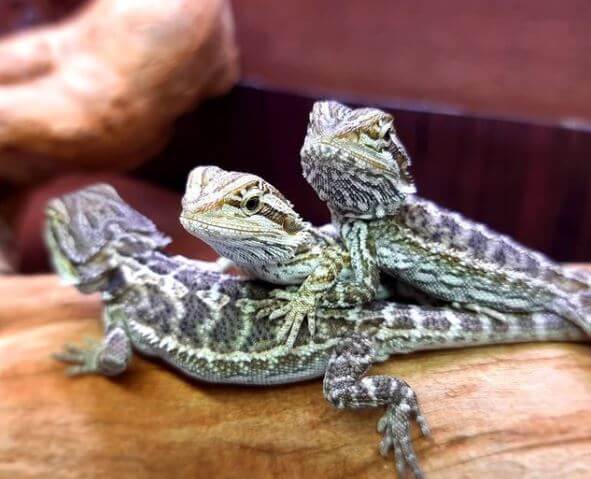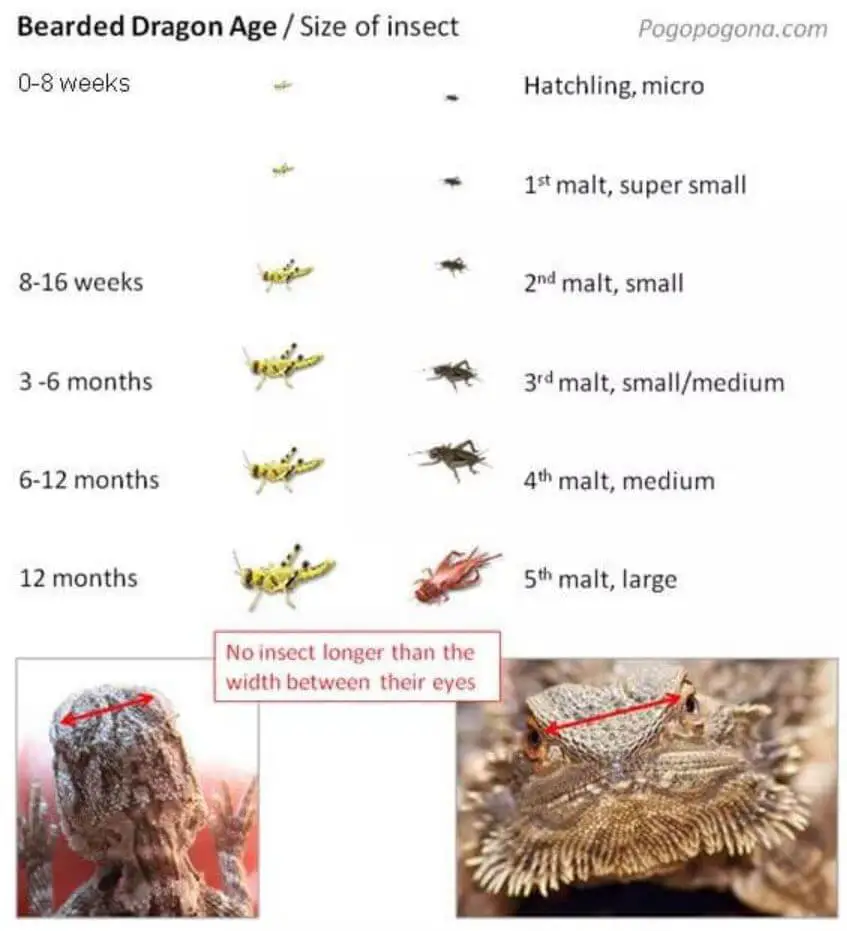“What food do baby bearded dragons eat?” will be the most considerable question, especially for the first-time beardie owner.
Starting with the newborn pet will be an unforgettable experience.
It will include both challenging and fantastic moments.
The babies are born a small 3” long and grow 16″ to 24” in length.
They are the same as human babies, sensitive, and it is not easy to take care of them.
It’s time to research and learn about healthy and nutritious diets and how to care for your baby.
Fortunately, I made this page to provide you with valuable information and tips for properly taking care of baby beardies.
However, firstly, those interested in having a newborn beardie start a new journey with beautiful friends.
Before picking a new pet, you should know something: Do not buy a beardie imported illegally from the wild.
You should choose a captive-bred pet from a trustable and reputable private breeder.
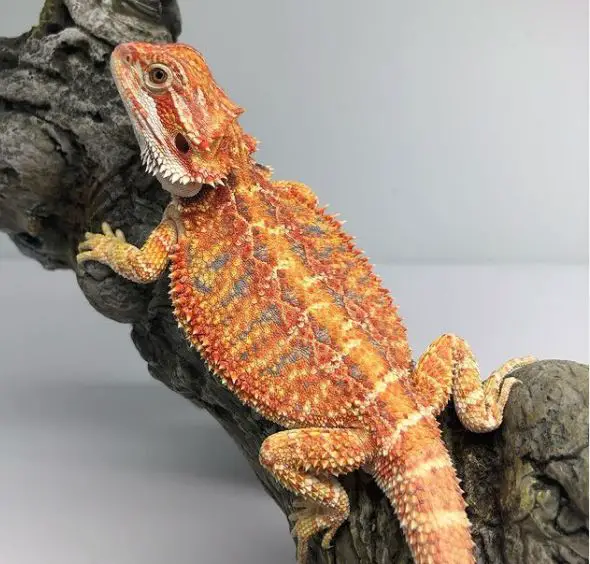
More importantly, there are some signs of a healthy baby as below:
- Bright skin and eyes
- Standing up with four legs
- Excellent posture and active in their cage
- Reactive to your touches
- Besides, you should know some illness signs:
- Swollen hind leg/rubbery jaw
- Not lethargic
- Watery/running stool
If you don’t know well about bearded dragons and their action, habits, etc., then you should buy some best bearded dragon books.
Reading books will help you a lot in taking care of your pet.
Now, what food do baby bearded dragons eat?
Related Posts:
- Top 9 Best Incubators for Bearded Dragon Eggs
- Dunner Bearded Dragon vs. Normal Bearded Dragon
- Why Do Bearded Dragons Wave and Bob Their Heads?
- How High Can Bearded Dragons Jump and How to Keep Them Safe?
- 8+ Bearded Dragon Dying Signs You Need to Know
What Is a Baby Bearded Dragon’s Diet?
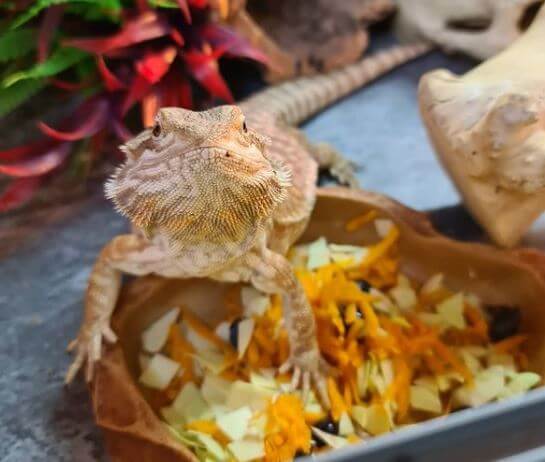
Knowing the diet for baby bearded dragons and what foods to feed them helps you keep them healthy and avoid health issues.
Feeding your pet with the right foods and maintaining the proper diet from when they are small will support them to make sure that they will live longer and, more importantly, they are happy all their lives.
Now, let us talk about what food do baby bearded dragons eat and their diet.
Like all living creatures, a baby beardie needs to eat a good diet regularly to remain happy and healthy.
If you are a newbie, you find it hard to know and remember everything.
But don’t worry, once you can handle the basics, it will be much easier as a piece of cake to get into a feeding routine for your tiny pet.
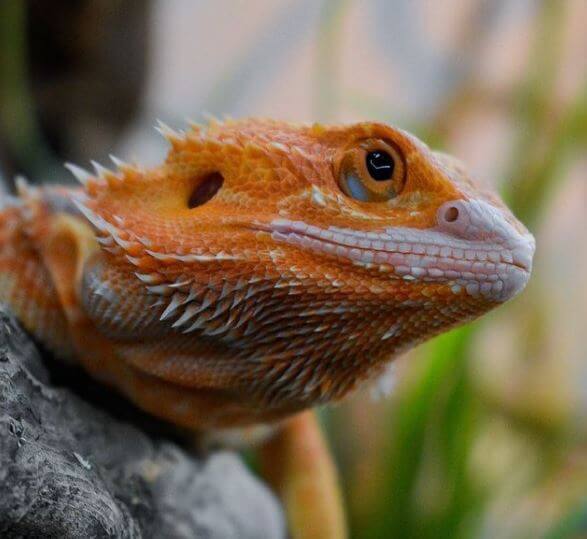
Beardies need a variety of different foods in their diet.
They will not consume all that they need from only food, so you need to provide calcium and vitamin supplements.
Knowing what food baby bearded dragons eat is the most important thing to do.
Usually, the diet for babies will be different from the mature ones.
So, what food do baby bearded dragons eat?
Baby beardie meals will consist of around 80% insects and 20% greens or vegetables, while the mature beardie will contact.
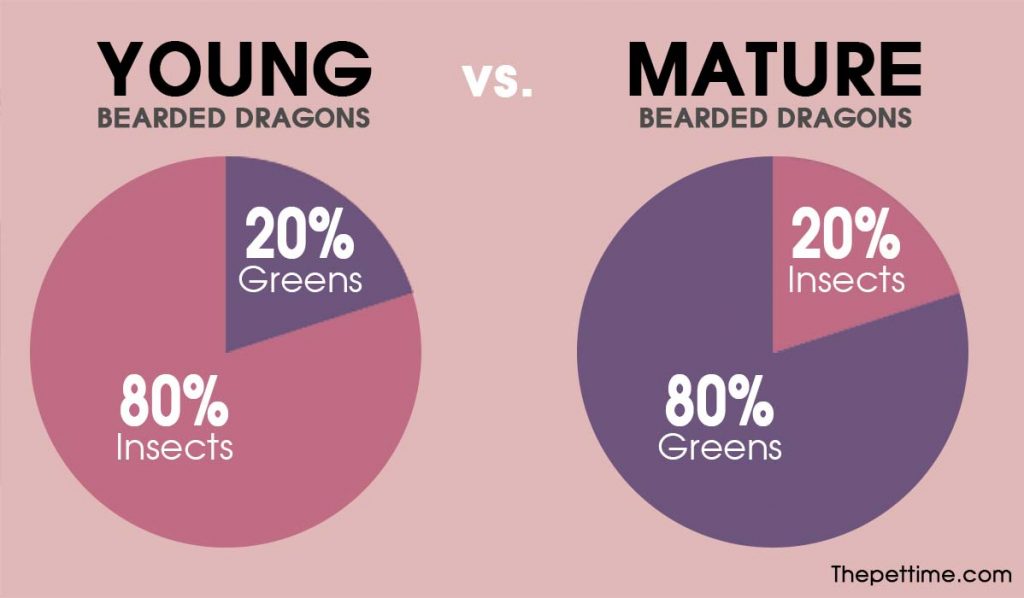
There are some very good greens and insects for beardie’s health. However, there are also some vegetables that you should not feed your pet or give as an occasional treat.
Besides, you also have to know how to feed them and how often you need to provide food.
I will help you out. Keep reading!
Firstly, you might need to know how many times beardies should eat and how often you should add nutritional supplements to their diet.
| Hatchlings
(Newborn up to 3-5 months) |
Juvenile
(5-18 months) |
Adult
(Over 18 months) |
|
| Frequency | 3-5 times/ day | 2-3 times/ day | 1-2 times/ day |
| Ratio | * 80% protein, 20% veggies | 80% protein, 20% veggies | 80% veggies, 20% protein |
| Calcium | Every feeding, 5 days/ week | Every feeding, 4 days/ week | Once a day, 3 days/ week |
| Vitamins | 1 time/ day, 2 days/ week | 1 time/ day, 3 days/ week | Once a day, 2 days/ week |
Note that for baby bearded dragons from 0 to 2 months, you should feed them as many crickets as possible in 5″ to 10″, 4 to 5 times a day.
You should also make sure the crickets are smaller than the space between your pet’s eyes to avoid impaction.
What Is a Baby Bearded Dragon’s Diet in the Wild?
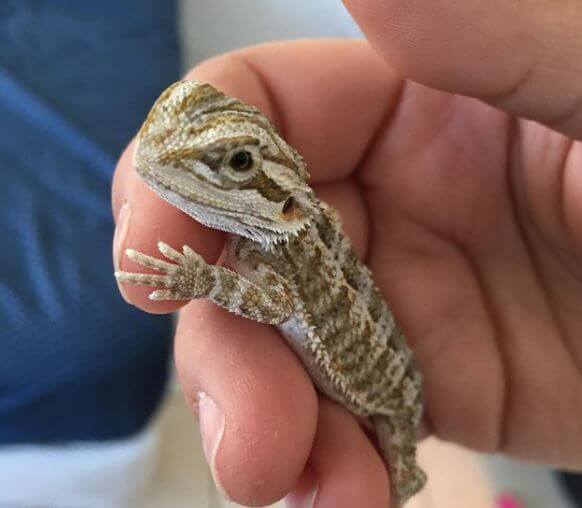
What food do baby bearded dragons eat in the wild?
There are a lot of options for you to feed your beardie. You might be confused about what foods you can give them.
You also might be curious about what food they eat in the wild.
In the wild, baby bearded dragons eat crickets and small insects such as termites and spiders.
Besides, they also forage for leafy greens and flowers where they can look for them.
The main difference between a wild diet and captivity is that the natural beardies feed a lot more protein than they do in the activity.
They have to roam around all day burning more calories, and they need the extra protein to make sure they have enough energy.
If you feed them in captivity as much protein as the natural beardie in the wild is accustomed to eating, they might get overweight and suffer from some health issues.
What Should Baby Bearded Dragons Eat?
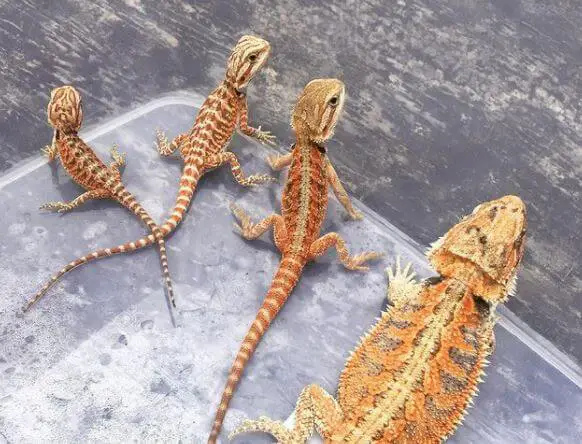
As mentioned, proper serving amounts of food depend on the size, age, and your pet’s personality.
They will stop to eat when they are complete, and you can pay attention to how much they eat and determine the serving size.
1. Protein
From newborn until reaching 18 months, 80% of a dragon’s diet should have protein.
After that, the ratio will flip with protein representing only around 20% of the diet.
You can put insects in a shallow dish when you want to feed your pet.
Don’t forget to remove the dish and clean the carcasses. Now, let’s see the baby bearded dragon food chart:
| Crickets | Juveniles can be fed pinhead crickets |
| King worms | Superworms |
| Mealworms | Don’t feed for hatchling |
| Wax worms | High-fat content |
| Earth worms | High fat content |
| Roaches | Being one of the best food
Hatchlings can eat the newborn roaches |
| Pinkie mice | Served frozen, for adults only |
- Table scraps – Do not feed pets with beef, chicken, pork, or meat from your food.
- Insects – Boxelder bugs and fireflies are poisonous to bearded dragons. Do not feed your pet wild-caught. It might come with trace pesticides or parasites, which can cause fatal.
Let’s see the content of primary feeders in the chart below:
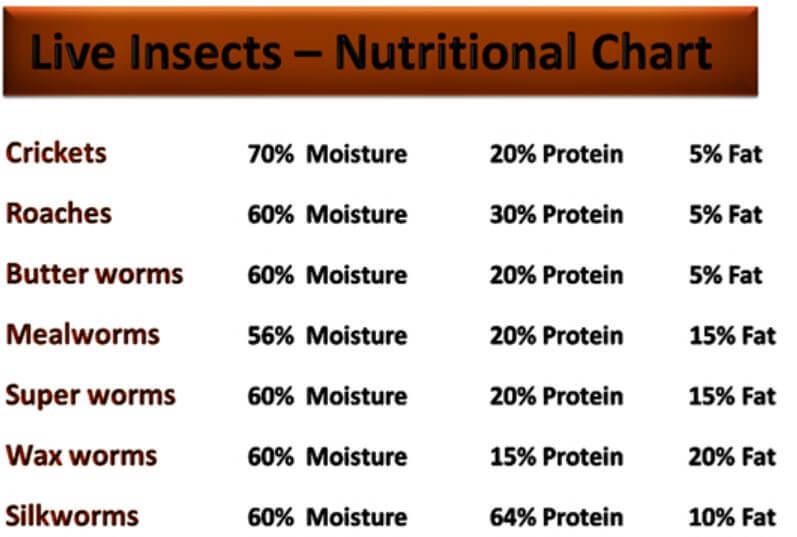
2. Vegetables
What food do baby bearded dragons eat?
Only 20% of the diet should be veggies for babies until getting adults, then 80% should constitute greens.
You can mix insects or colored fruits treated into the salads for support to get the dragon used to eat the greens.
Let’s see what vegetables can a baby bearded dragon eat!
| Staple leafy green | Turnip, collard greens, watercress, escarole, and mustard
Iceberg and some lettuces are popular in our salads, which provide good hydration/water content but are not essentially nutritious. |
| Treat greens | Swizz chard, Cilantro, kohlrabi leaves, bok choy |
| Staple veggies | From all kinds of squash
Root vegetables: Parsnips, carrots, sweet potato |
| Occasional veggies | Bell pepper, beets, asparagus celery, bell pepper. |
| Staple fruits | Mango, peach, papaya |
| Occasional fruits | Bananas, berries, melon, apples, peaches, figs, kiwi, grapes, etc. |
Avoid feeding your pet with tomatoes, spinach, and beet greens.
Rhubarb and avocados are poisonous for beardies, and you should not give them these fruits.
3. Water
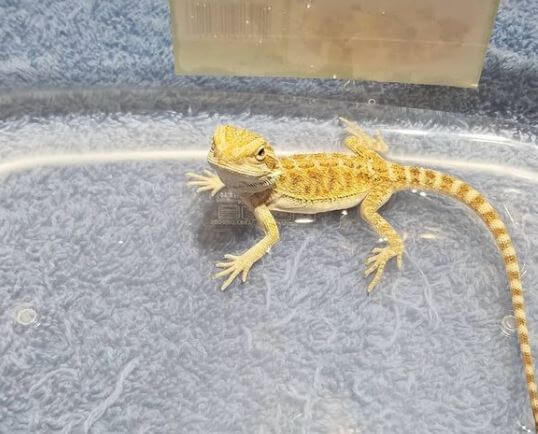
Babies should stay hydrated, but many of them might not drink from the water dish. If you think your pet does not get enough water, you can measure it this way:
- Ensure the water in the dish is clean always.
- Put a piece of colored fruit or a small mealworm in the water. Your beardie will drink water while eating.
- Mist water on the salad before serving.
- Spray a mist of water on your pet, and she will lick up some droplets.
Your beardie will stay healthy and live a long, happy life with a well-balanced baby bearded dragon diet and adequate hydration.
Now, let us answer the question, “What food do baby bearded dragons eat?”
What Food Do Baby Bearded Dragons Eat?
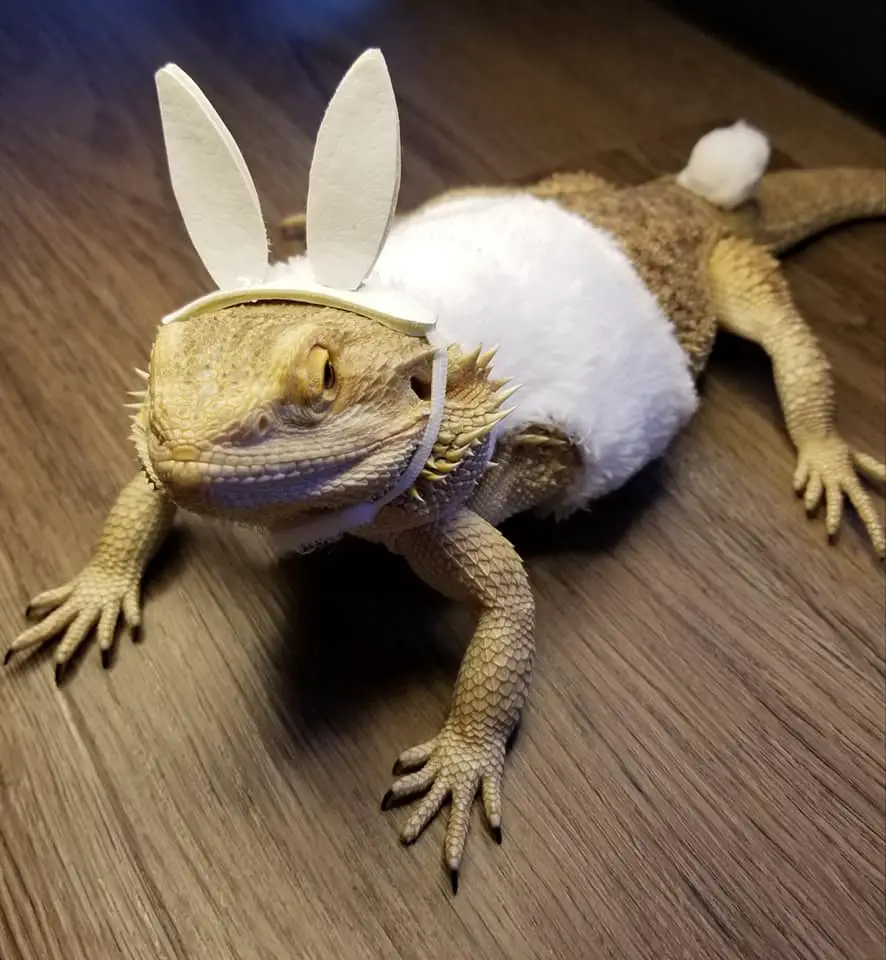
1. What Food Do Juvenile Bearded Dragons Eat?
For juvenile bearded dragons, you should feed them as many crickets as they can eat 2-3 times/day for 5-10″ intervals until they are up to 9 months of age.
From 9-12 months, you can feed them 5-10″ and two times/day.
When they are 12 months of age, you can start slowly feeding them with the adult diet.
You can change the proportion of feeders to greens and vegetables.
You should stop allowing them to eat as much as possible and instead provide them with an amount twice every day.
For instance, if your pet is familiar with eating 20 feeders twice every day for 40 crickets in total, you can try to give them 15 crickets twice/day and instead supplement it with more greens and vegetables.
Juvenile is the time your pet should begin to explore adult foods, especially vegetables and greens.
At this time, you should start to give them more vegetables and greens and allow them to try many types as well.
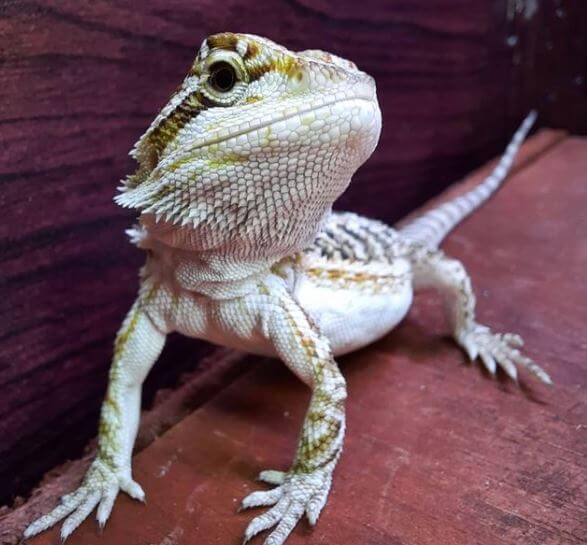
When they are 12 months old, you can get a diet that is roughly 50/50 between insects and greens.
Up to 18 months old, they should raise to be around 80% whereas the insect will be lower portion about 20%.
Calcium and Vitamins
The amount of vitamins and calcium for bearded dragons should be kept until 12 months old.
This time, lower the calcium to 3 times/week and vitamin to one time/week.
Once they reach 18 months old, you can lower the D3 to twice/week.
For more information, watch this video!
2. What Food Do Adult Bearded Dragons Eat?
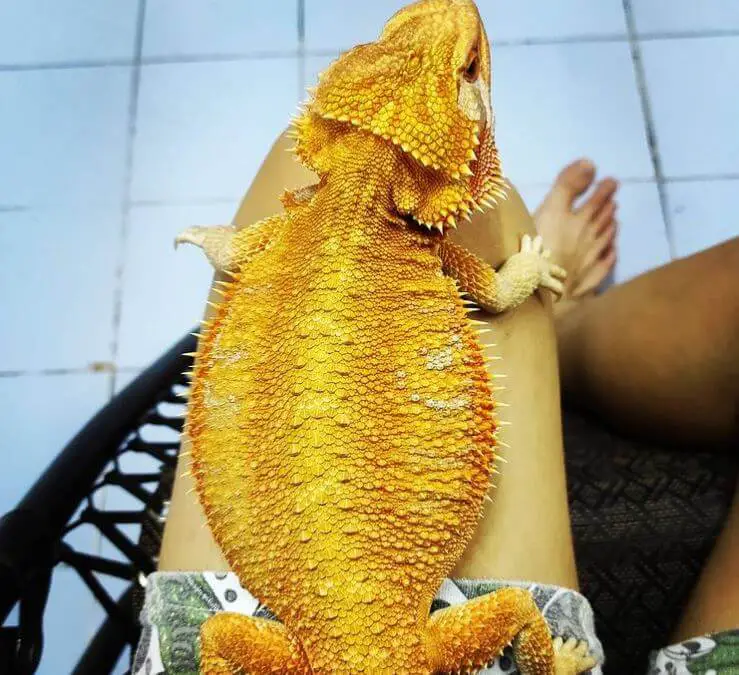
Now, Let’s take a little time to talk about what you should feed your mature beardies for excellent health.
As mentioned, the adult bearded dragon is at least 18 months old.
a. Feeders
The mature beardie needs a staple source of protein, so you might need to provide them with insects.
However, they will not need as many insects as before as they do not grow anymore.
How many feeders to feed your beardie will depend on their size.
Some mature beardies who are quite big can eat two as many crickets/week.
b. Greens and Vegetables
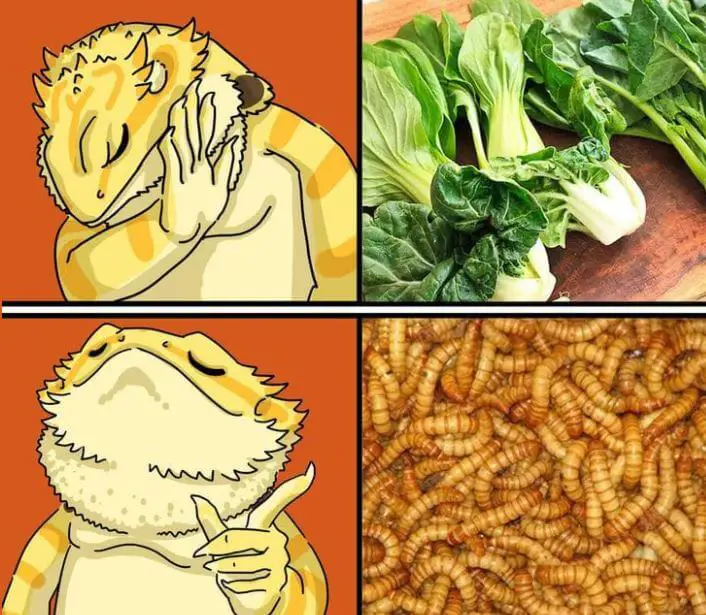
Adult beardie will be healthy on a diet of 80% greens and vegetables.
You might want to give them a nice and fresh salad. If your pet is not enthusiastic about the greens, try to mix them up a little.
c. Calcium and Vitamins
For adults, you can reduce the amount of calcium just 2-3 times/week and the multivitamin once/week.
Ensure that the food will not get dusted more than once/day
For more information, watch this video:
3. What Food Do Baby Bearded Dragons Eat?
What food do baby bearded dragons eat?
a. Greens and Vegetables
Although babies need small amounts of greens and vegetables, it is also important for their diet.
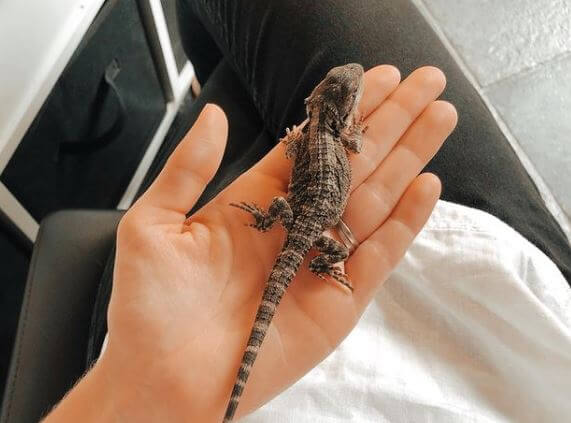
b. Calcium and Vitamins
This stage of life is important for your beardie. Dusting the feeders with calcium supplements once a day and 5 days a week would be great.
However, never do it twice/day. On 2 days/week, they will not receive these supplements, so douse the feeders with multivitamins.
Normally, they should eat feeders doused in something once/day and every day.
c. Feeders
This is the most important part of a baby’s diet because this food is rich in protein, which all babies need.
For the small babies from 0-2 months and 3-4 months, feed them crickets as many as they want.
How to Prepare Food for Baby Bearded Dragons?
Let us talk about how to prepare food for them now that you know the answer to the question, “What food do baby bearded dragons eat?”
Before you give your pet specific foods from the best baby bearded dragon diet that they can eat, there are several things you need to know about preparing foods and supplements to feed them.
1. Dusting and Dizzying
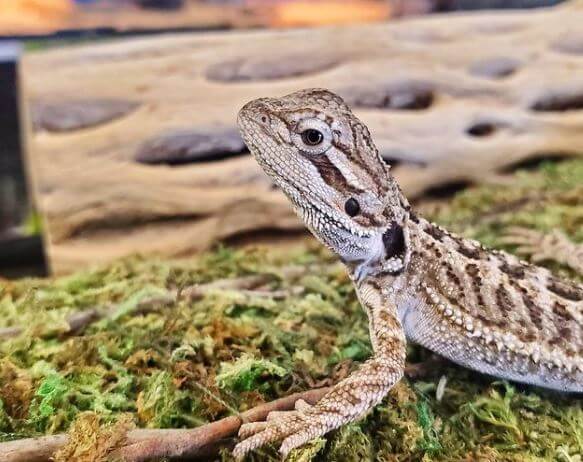
Beardies need vitamins and calcium. These supplements will come in powdered form, which can be dusted on your pet’s foods.
It will be perfect for dusting the veggies. However, you can do both by dusting the insects as part of dizzying.
When you prepare a meal for a pet, you should put the insects into a small box or plastic container, dust the supplements on them, then don’t forget to shake a little.
Do not shake too much. You will not make the martini, and you will not expect the bugs to be killed from whiplash. Your pet needs to consume it alive.
You should know how to shake and when to stop shaking. You should shake only enough to coat them with the dust and get the tiny noggins rattled.
Finally, you can serve them up!
2. Gut-loading
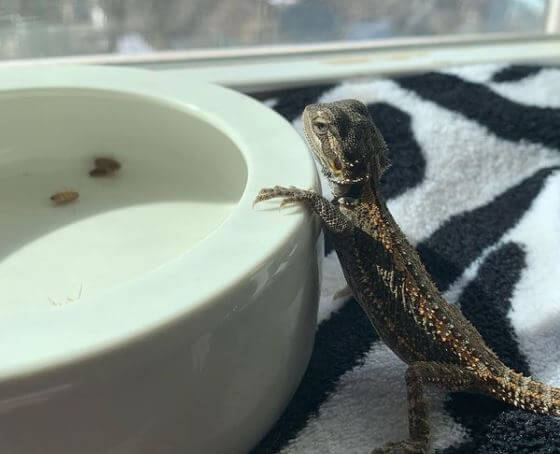
Beardies like to eat live insects to stay healthy.
The insects do not have a lot of nutritional content.
However, it will have a significant value if you gut-load them.
Gut-loading is fattening up the insects before they are fed to your pet.
You need to fill the tiny tummies with good stuff, then when your beardie eats them, she will get the significant benefits of the insect’s meal.
Feed the insects in the tank for up to 48 hours before feeding to your dragon.
You can give some veggies that your pet eats or a particular food mixture from the store. Some beardie lovers feed their insects tiny foods.
3. Warm Foods
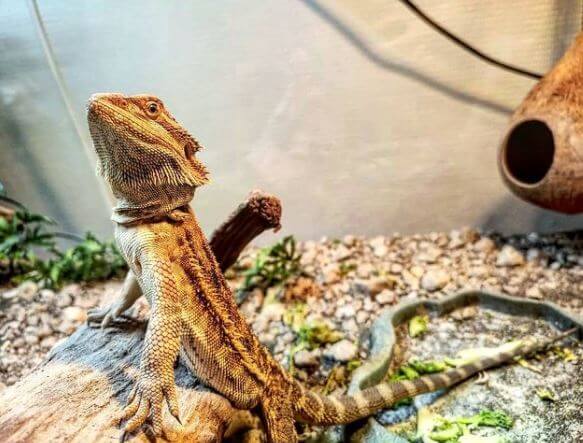
Your tiny pet’s food does not need to be heated up before feeding. However, your pet does.
The dragon wants to be warm to digest food well.
Do not serve breakfast immediately after bringing up the lights for the day.
You can give your pet some time to warm food up before feeding.
Also, it is better to give at least 2 hours to digest after dinner and before turning down the lights for nighttime.
Now, it is time to take detail about their diet.
How Often Should You Feed Baby Bearded Dragons?
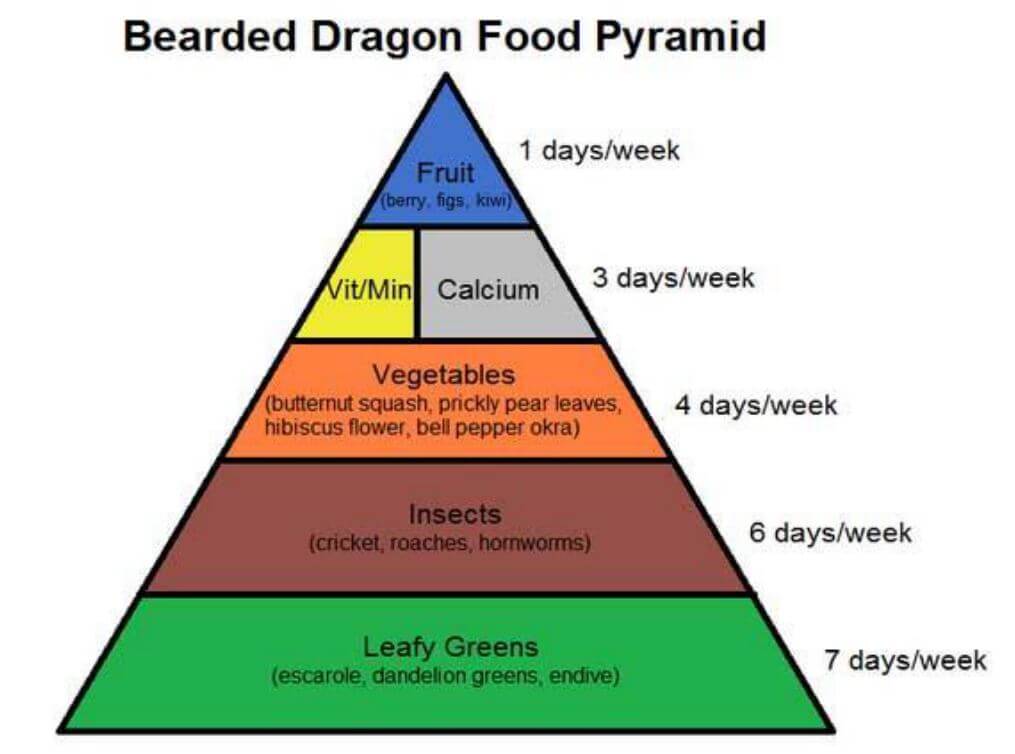
You might be curious about how often you feed your pet. I will let you know later.
Firstly, you should turn the lights on around 30-60 minutes before feeding and leave them for as long after feeding.
The reason is that your beardie needs to warm up to have a strong-enough appetite to eat.
Besides, don’t forget to remove all food that is not eaten within 30″ or less.
1. Adult and Juvenile Bearded Dragon Feeding Schedule
You should feed them half of the food in the morning time and half at night.
If you are too busy, you can feed them all the food once a day.
I recommend you slowly remove the salad because they will need to wait 24 hours to get more food.
2. Baby Bearded Dragon Feeding Schedule
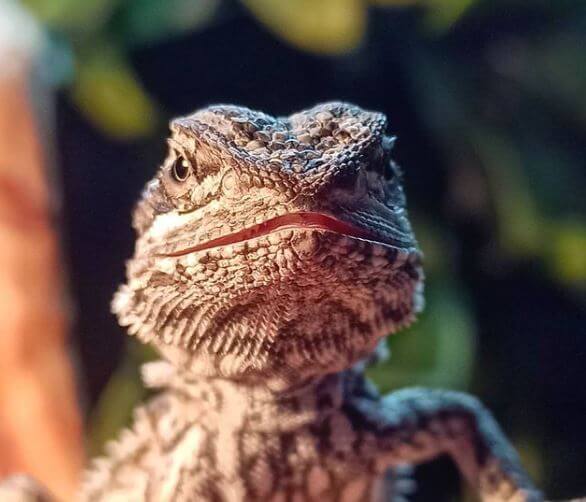
For the babies from 0-2 months, you should give them as many crickets as they can eat in 5-0 periods, 4-5 times/day.
You might wonder how many crickets should a baby bearded dragon eat per day. Your babies should eat from 30-60 crickets/day.
For the beardie babies from 3-4 months, you can reduce feed to only 3-4 times/day. Still, let them eat as much as they want in 5-0 windows.
For 8-9 months old beardies, you should continue the schedule.
However, at this age, your dragons need to be fed with added protein and allowed to indulge because they will keep growing for the next 7-10 months.
If you feel that your pet slowly grows, you should adjust the diet to a staple amount of feeders/day.
How to Feed a Bearded Dragon?
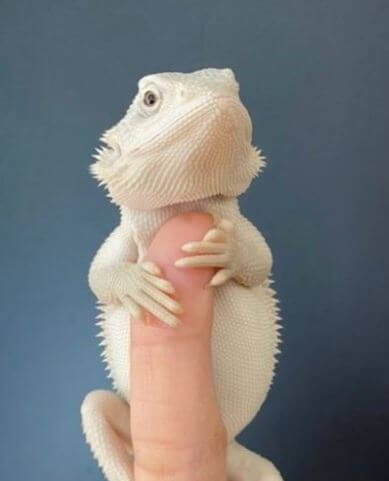
There are several beardie feeding tips that might be useful information for you. Let’s check it out!
1. Baby Bearded Dragons
The babies are from newborn to 4-5 months old.
What food do baby bearded dragons eat?
This time, they are very fragile, so it is crucial during this stage that it gets ample vitamins and nutrients.
You should consider well the size and amount of food given during this critical period.
Do not give the baby birdies prey foods that are larger than their head.
The giant insects can cause the beardie severe injury or even fatal.
Baby dragons have a large appetite and will love to eat prey that is too big.
However, if it happens, then they can easily slip into paralysis or even die.
Feed them with pinhead crickets around 1.5 inches and tiny fruit flies and trim wax worms.
It will help ensure that the baby dragons can chew and digest the food without any issues.
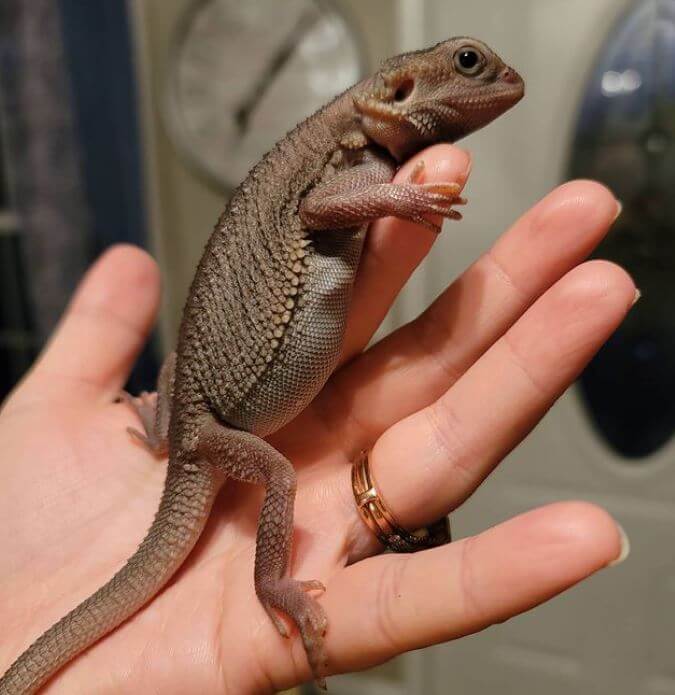
A baby beardie eating mealworms is not recommended. It has a tough outer shell.
Hence, it will be difficult for the baby to digest and could lead to some paralysis.
Baby beardies also have a high metabolism, need to be felt small, and more frequent meals.
Babies have different nutritional requirements than adults.
Their diet should contain about 40-60 percent of proteins and 20-40% of vegetation.
You should give them the small insects 3-4 times/day and chopped vegetables at least three times/week.
Feeding the finely chopped vegetable once/day is optimum.
You should avoid overfeeding your babies because it might cause obesity and long-term health issues.
If you want to know baby beardie daily routine, check this out:
2. Juvenile Bearded Dragons
From 5-10 months old is considered as juvenile. At this time, beardies have gained mass and several fat reserves and can be fed less frequently.
The ratio of insects to vegetables will change.
You can cut down the number of insects to one feeding/day with juvenile dragons, while vegetables and greens should be provided at least four times/week.
Insects can be giant, but don’t forget to feed them anything larger than their head.
You should offer the mealworms once or twice time/week. At this stage, you should consider carefully giving them more vegetables and fewer insects to prey on.
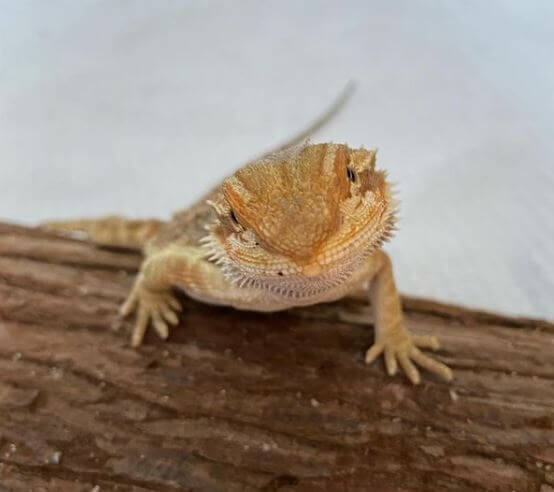
3. Adult Bearded Dragons
The bearded dragons are adults when they reach the age of over 18 months old.
At this time, the feeding schedule becomes more subdued, except for female inbreeding.
The adults can give a flexible and balanced diet of vegetables and insects.
It is great to offer more fruits and vegetables.
The adult diet should contain 20-25% insects and 70-80% vegetables.
The adult beardies can be offered with softened rabbit pellets and canned dog food.
These foods should be offered as an occasional treat and only once/three weeks to a month.
Adults are susceptible to obesity, so you should keep an eye on their development rate and only change the amount of food given.
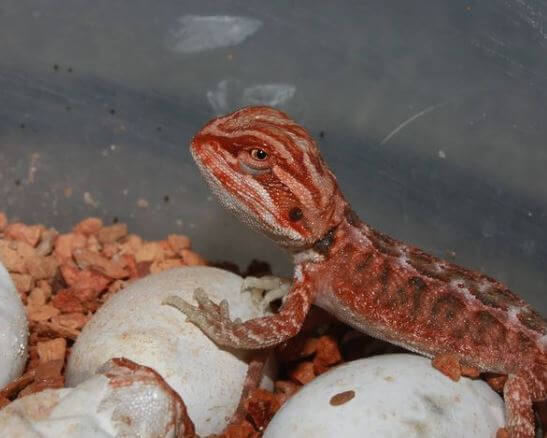
How Do Bearded Dragons Grow?
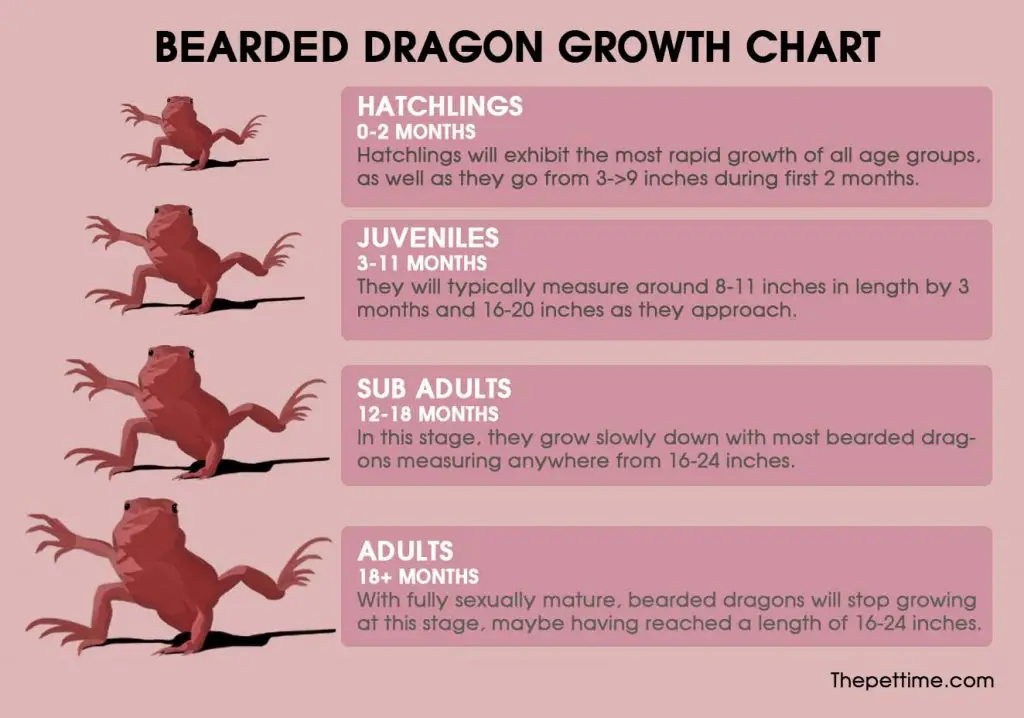
1. Newborn Bearded Dragon Size
A newborn baby beardie will measure around 3 inches in length and weigh around 4g.
Until getting to 2 months old, they will have doubled or tripled their length and gained from 4g to over 30g.
They will grow fast if you provide them with the perfect baby bearded dragon diet.
2. Juvenile Bearded Dragon Size
At this stage, the size will be from 8 to 23 inches in length and weight from 20 to 400g. Juvenile beardies are between 3 to 11 months old.
At this stage, these beardies experience the most dramatic development rate.
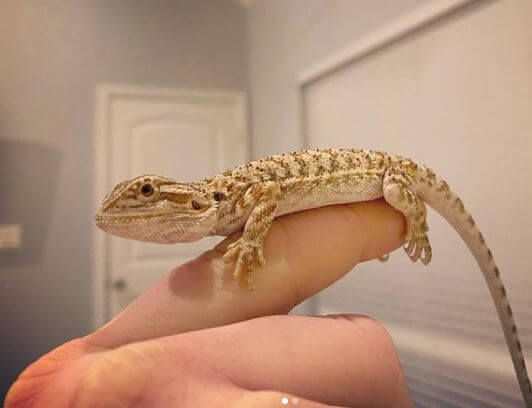
3. Sub-adult Bearded Dragon Size
The sub-adult beardie size will be from 15 to 24 inches and weigh between 300g to 500g.
Their age is from 12 to 17 months. During this time, their size will change a little and the weight might only gain 20g.
4. Mature Bearded Dragon Size
The full size of the beardie, as I mentioned, is around 16 to 24 inches in length and around 300g to 550g in weight.
However, they even can reach longer in length up to 26 inches.
The full-size male will always be bigger and longer than the full-size female.
What Affects the Size of Bearded Dragons?
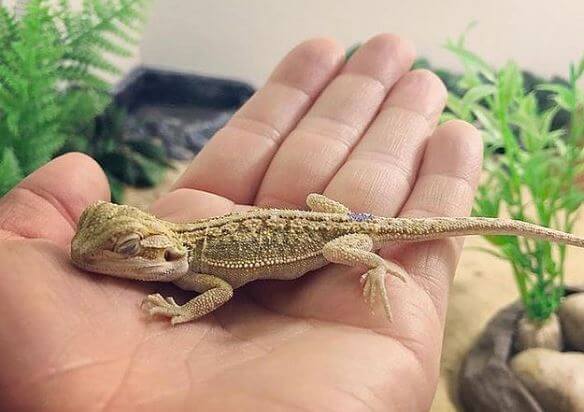
Here are the factors that affect the size of bearded dragons:
- Gender
- Diet
- Breed and genetics
- Enclosure quality and size
1. How Big Does a Bearded Dragon Get?
Naturally, a beardie’s full size will measure between 16 to 24 inches and weigh between 300 to 550 grams, with an average weight of around 400g
They will grow to the full size when they are 18 months old.
2. How Long Does a Bearded Dragon Get?
At one year old, the beardie should be from 16 to 18 inches.
At this time, they will slowly slow down in their growing process.
For getting clear about the bearded dragon’s size and growth, let’s take a look at the chart below:
| Age | Length (inches) | Weight (gr) |
| 1 month | 3-4 | 4-6 |
| 2 months | 5-9 | 8-40 |
| 3 months | 8-11 | 20 -110 |
| 4 months | 9-12 | 40-115 |
| 5 months | 11-16 | 100-150 |
| 6 months | 11-18 | 180-225 |
| 7 months | 13-18 | 225-280 |
| 8 months | 13-20 | 230-325 |
| 9 months | 14-21 | 250-350 |
| 10 months | 15-22 | 260-375 |
| 11 months | 15 – 23 | 280-400 |
| 12 months | 15- 24 | 300-450 |
| 18 months | 15- 26 | 300-550 |
Why Is My Baby Bearded Dragon Not Growing or Gaining Weight?
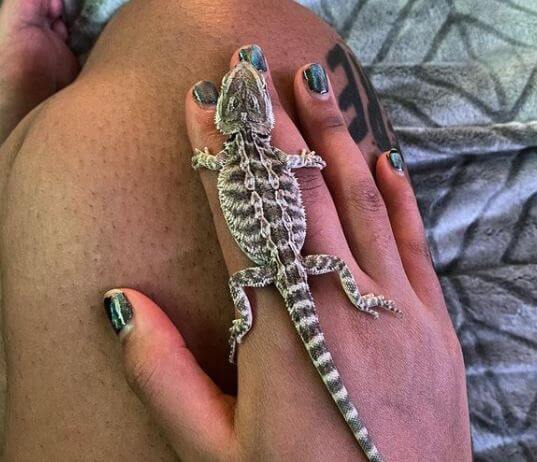
If you see your beardie is below the average weight based on the chart above, your pet might get some problems.
Keep reading below to discover more details about it and how to solve the problem.
1. Inadequate UVB Exposure
If your baby’s habitat doesn’t have an excellent UVB bulb, it can lead to slower or stifled growth.
They do not get enough UVB to absorb calcium from the diet. It will cause some severe health problems.
To make sure your pet is absorbing an optimal UVB amount, you should change the bulb every six months.
If your pet has the right quality mercury vapor bulb, you can wait for a longer time, around ten months, before changing.
2. Insufficient Diet
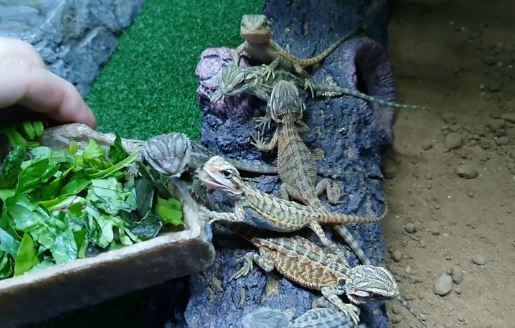
Babies need as much protein as they can eat to grow well.
If your pet is under three months, you should feed it with crickets five times/day, from 5-10 minutes.
Although greens are the staple in the baby bearded dragon diet, it is not essential until the 12-month age stage.
3. Brumation
It is the reptile version of hibernation, which happens when your pet hunkers down and sleeps for a long time as he anticipates winter.
When they get through brumation, they will lose some weight because they spend a lot of time sleeping and not eating food.
You can avoid the brumation by making sure the temp in their cage stays where it should be year-round and making sure the lighting cycle is regular.
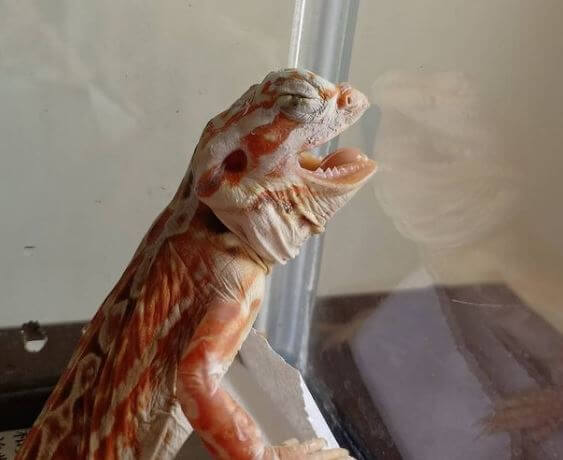
4. Diseases
If your beardie gets sick when they are growing, they can experience stunted growth.
Usually, sick babies will not like to eat.
If they are growing without eating, they will become weak and stop growing.
Besides, the internal parasite can lead to slower or stunted growth because it will rob your pet of the nutrients they eat.
If your pet is experiencing diaphysis or their waste is smelly, and their diet has changed, they might have parasites.
However, you should be aware of what healthy pet poop looks like, and it can help you better recognize parasites’ presence.
Don’t worry as we can always prevent the illness by making sure your perfect baby bearded dragon diet and habitat.
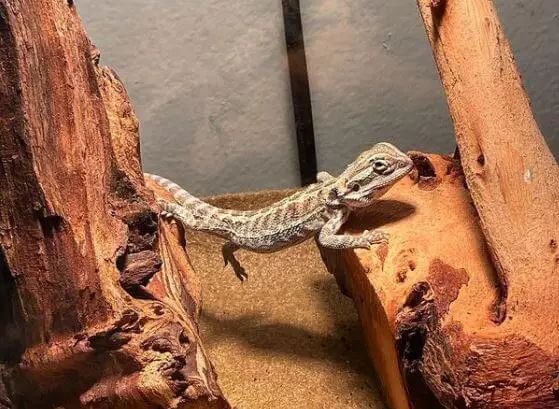
You can do several things, such as deep cleaning the entire tank regularly, removing all the waste at first sight, and keeping the water and water bowl clean.
Besides, you should try to reduce stress, follow up the humidity, provide enough UVB, and provide adequate calcium and vitamins.
How to Know If a Baby Bearded Dragon Is Underweight?
The underweight beardies will have wrinkled skin, and the skin hangs from the body. Besides, the fat pad on the back will appear sunken in.
A normal beardie’s fat pad will be raised.
You should check up on his weight right after you feel they are underweight.
The most common reason for it is a cold cage. If he cannot warm up, then he will experience a decrease in appetite.
You should ensure the lighting and temperature are set up for a specific age.
Besides, your pet might not light the baby bearded dragon diet you are providing them, then they do not want to eat.
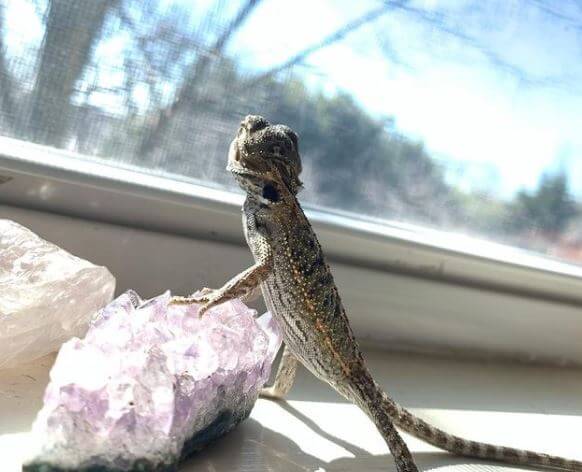
To help them recover and grow in size and gain weight, here are things you can do:
- Firstly, provide them feeders with high fat such as butter worms, superworms, etc.
- Secondly, provide appetite stimulants.
- Thirdly, provide the supplement with homemade slurry.
How to Know If a Bearded Dragon Is Overweight?
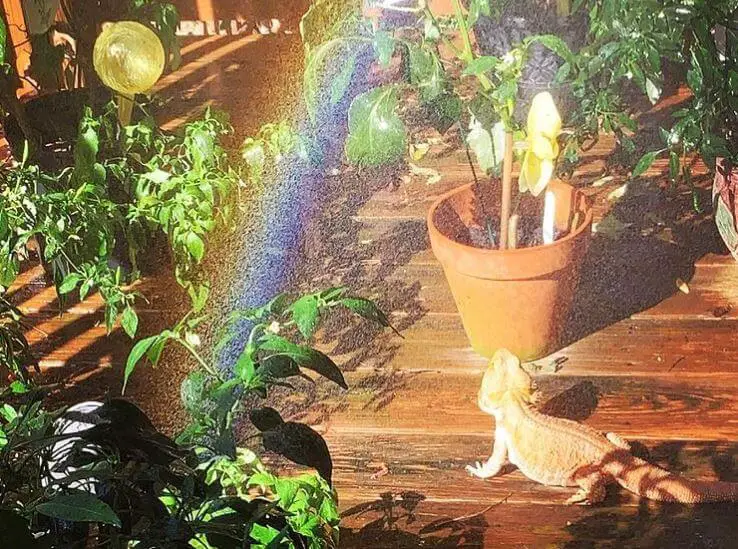
The overweight babies will look round with the belly seen from above, with fat legs and a full chest.
The reason is that the temperature is high. It will lead to the bigger pet because the temp will trigger their appetite and lead them to overeat more than they usually could.
For losing weight, you can do something below:
- Offer low-fat feeders such as hornworms or crickets.
- Let them exercise with the playpen outside.
- Feed them more greens and vegetables instead of feeders.
- Go for a walk with a leash.
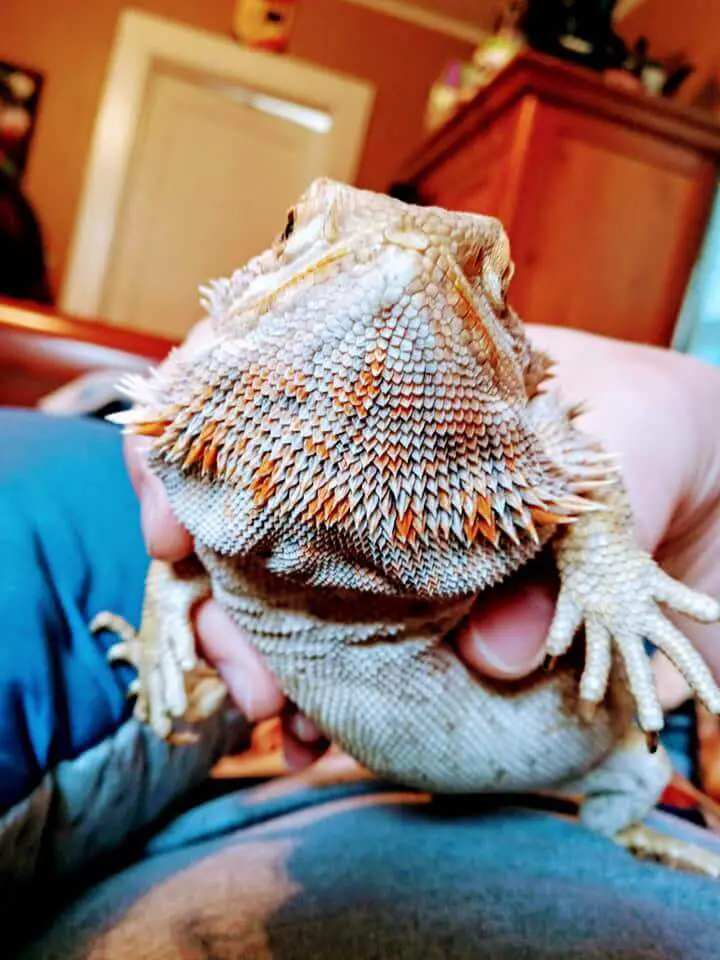
How Much Is a Baby Bearded Dragon?
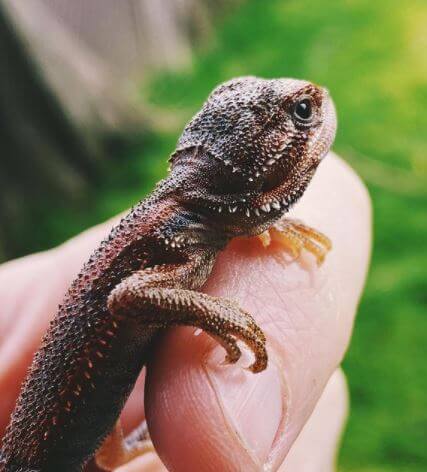
From $50 to $100 is the range of price for buying a bearded dragon.
Some pets that are not tan-brown will be much more expensive.
Besides, you should consider buying an initial setup if you are not experienced.
The enclosure might cost from $200 to $1000, including the 20-gallon terrarium, hides, food, lights, and substrates.
You can buy the starter kit for around $200, but it might not include the good supplies.
What to Consider When Having a Baby Bearded Dragon as Pet?
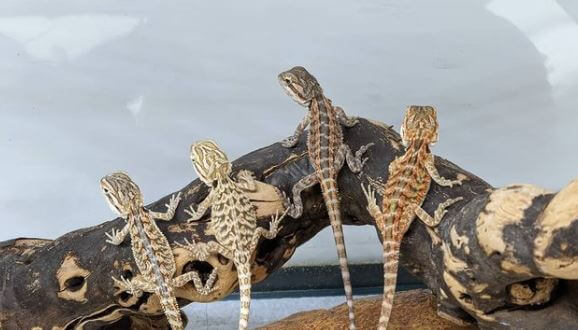
1. Adjustment
The new habitat is a crucial part to improve beardie health without a good baby bearded dragon diet.
Moving to the new habitat will be a weird experience for baby dragons.
You should know that he will not eat for several days and typically eats for up to 2 weeks.
You should not buy too young dragons (less than six weeks) because it is impossible to survive during this settling time.
Leave him to settle in for two weeks before handling him, and he needs to get used to you as the person who feeds him every day.
It is also a way to help them get the instinct to hide away or escape from the dangers.
When you start to handle him by your hand underneath him, scoop him up, and hold him firmly, they will not fear heights and are likely to jump off your hand and get hurt because of landing on the hard floor.
Thus, you should be careful.
2. Enclosure
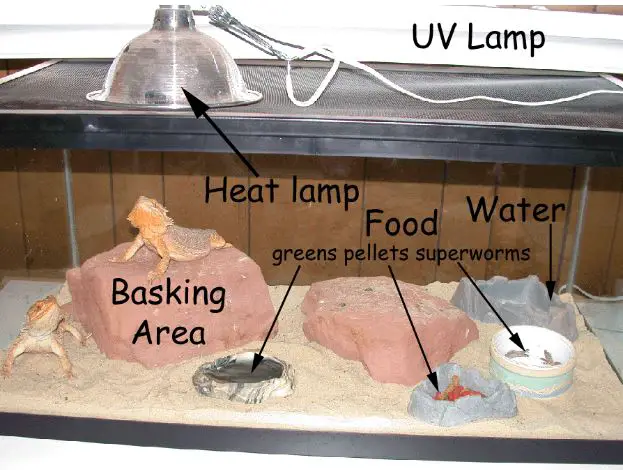
A baby beardie will need a 20-gallon tank, they will grow, and you should grow your tank size.
An adult needs a 120-gallon tank.
Let’s check this out to know more about tank size for beardie:
| Age (month) | Enclosure size |
| 1 | 20-gallon |
| 2 | 30-gallon |
| 3-6 | 50-gallon |
| 7-9 | 75-gallon |
| 12+ | 120-gallon |
Some pet lovers like to start with a small tank for a baby dragon because the baby with a big tank might feel lost in the large environment, and it is also challenging for them to find food.
However, the baby dragon will grow very fast, and I always choose the adult cage to start.
Then I don’t need to buy many enclosures.
If my beardie feels lost, I can block off one-half of it. Besides, it is also easy to get the temp gradient right in the big tank.
3. Lighting
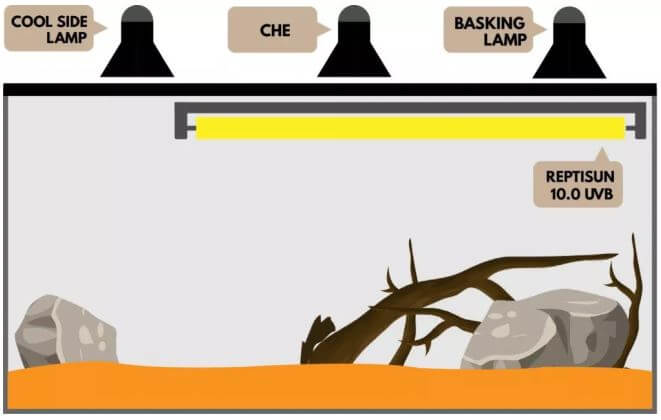
As mentioned, 12 hours of daily light is needed for babies.
Bearded dragons need both UVA and UVB lights.
UVB light tubes should be on for 12 hours from 7 am to 7 pm.
You can buy a light timer to control it properly.
50-57 Watt UVA bulb should be used in the dome light fixture.
The light can be placed on the screen lid top or hung inside the tank.
You should get the UVB light that is tube-shaped and not coiled.
The UVA bulbs should be the dome so your pet can bask comfortably.
4. Heat and Basking Temperature
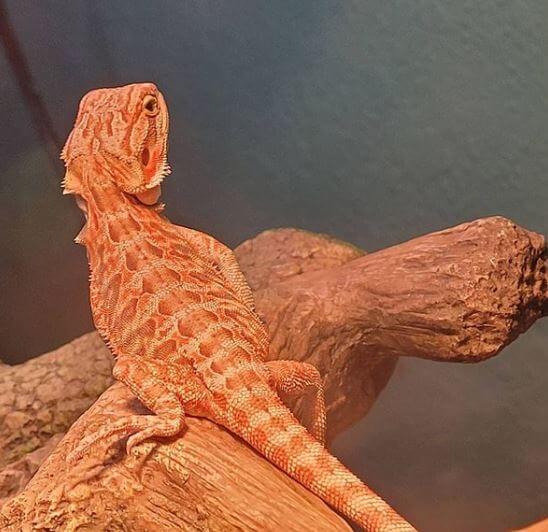
The enclosure needs the temp gradient, and it allows your pet to move in and out of the basking spot.
The basking area should be set around 95 to 105 degrees F.
The basking area will be the hottest place in the terrarium.
It should be designed on the right or left side of the tank.
If the UVA light is set up on the cage’s cold side, it should be around 75 degrees F.
It is crucial to have two thermometers for each side of the tank. You should ensure that your pet has the correct heat.
If the item is low during the night, specifically below 65 degrees C, you should add the ceramic heat emitter.
5. Humidity
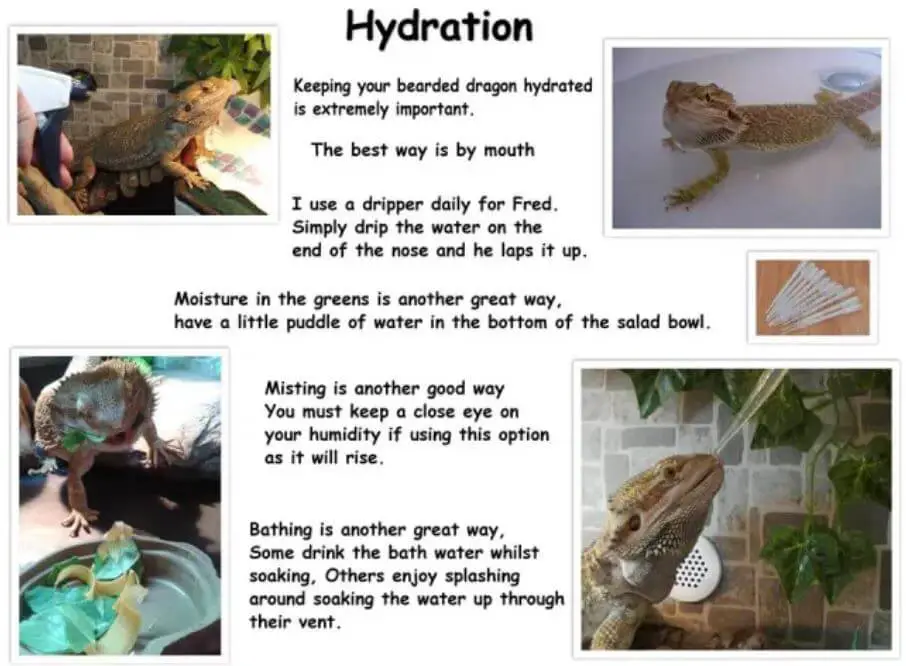
The beardie’s enclosure should be from 30-40% humidity. If the tank is too humid, the pet can get sick.
If it is too dry, the beardies can dehydrate.
You should invest in a high-quality hygrometer for measuring water vapor levels.
The best way to reach good humidity is to include the water dish in the tank and allow the water to evaporate.
The water dish should be shallow enough for the baby beardie to enter and go out by themself. The water should be filled more diminutive than their chin.
6. Substrate
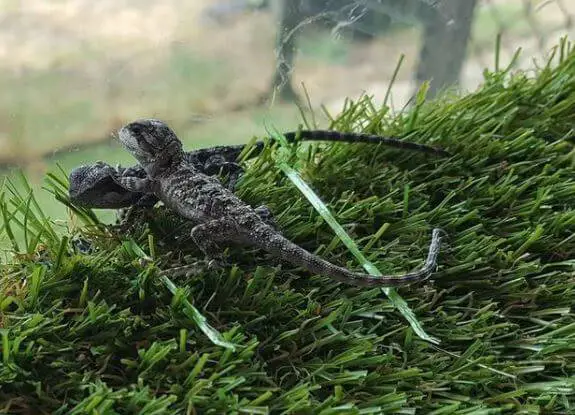
Using reptile sand in a baby beardie cage is a big mistake that many owners make.
Although he lives in the sand in the wild, your dragon should not be kept on the sand as a substrate.
The human-made sand will be different from the natural sand.
If your pet is living in the sand, it will get inside his eyes, the water, and food.
If the baby beardie consumes a lot of sand, its intestines might be blocked, causing the impaction
The best substrate for babies is a reptile carpet. You also can use paper towels, newspapers, or non-adhesive shelf liners.
What Are the Right Conditions for Baby Bearded Dragons?
1. Temperature and Light
You should monitor the temperatures inside the enclosure well. Baby beardies can overheat and dehydrate quickly in a small tank with a lot of heat.
You should ensure that your pets consistently access the warm basking area and the more excellent areas in the tank.
Adults dragons can comfortably and safely bask in the temperature up to 130 degrees F.
However, they can stay for a short time, and the large tank will let them warm up slowly and safely.
Baby dragons have basking spots with less hot than 95 to 100 degrees F.
You always use a good quality thermometer for reptiles instead of guessing the temperature.
Many users find that using two thermometers can simplify monitoring highs and lows by removing the single device’s need.
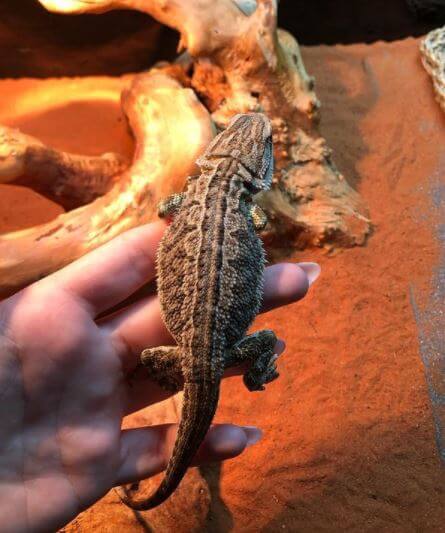
A full-spectrum lighting system is necessary for the extended maintenance of every lizard as bearded dragons.
They should be provided with 10 -12 hours of whole light. You can buy a bulb designed for this purpose, and they are fluorescent tubes.
Related Posts:
2. Hydration
Dragons can become dehydrated. In the small tank, it will lose moisture quickly in hot and dry environments.
Besides, they should be misted every day with room temp water in a shallow water dish.
The tank contents can also be misted, but try to direct the stream to animals.
Frequently Asked Questions About Baby Bearded Dragons
1. Why Is My Baby Bearded Dragon Not Eating?
There is some reason causing beardie to no eat.
a. Brumation
In brumation time, the reptile will respond to lower temp, which often comes in rainy time or winter, by storing energy and slowing down energy.
For baby beardies, you find them hide consistently and do not touch the food. They do not move much during this time, too.
b. Low Temperature or UVB
The beardie converts the heat into energy.
Thus, when the cage is not hot enough, your pet will be low on energy and not eat.
Thus, you should ensure that you have an excellent thermometer suited for your pet cage to get an accurate reading of basking spot, temperature, and cooling spot.
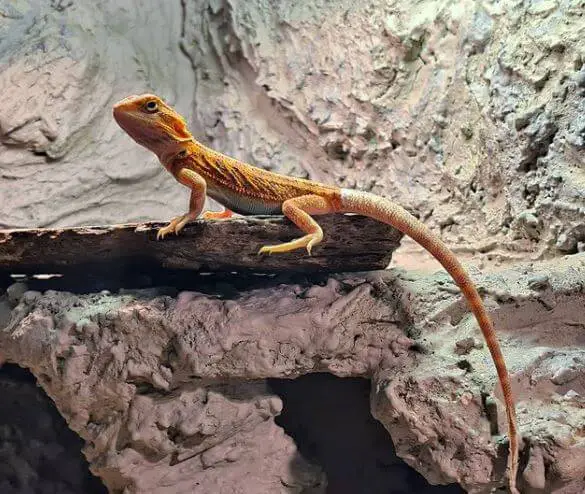
c. Constipation
This sometimes happens for baby beardies.
You should go around once a day with your pet.
The juvenile should go every other day.
Then you can help them to massage their bellies, using laxatives and bathing them gently.
See the vet immediately if nothing works.
d. Stressed
Stress is very natural. Young beardies are more likely to be targeted as prey.
There are some reasons why they get stressed such as the rapid change in light, other reptiles affected, loud sounds, new environment, or new people handling them.
They will not eat if they get stressed.
To solve this problem, you can remove the overstimulation, provide them with a safe habitat, and get them used to your scent.
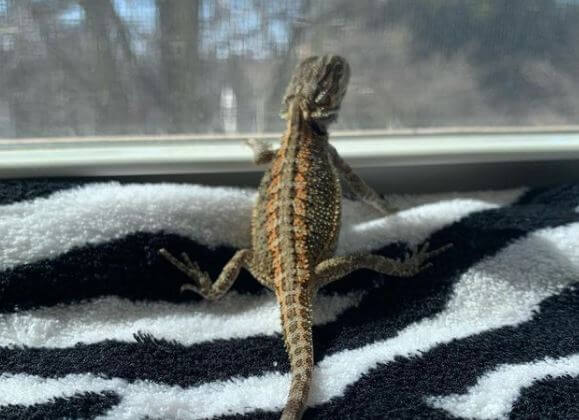
e. New Food
The beardie will refuse the new food for the first time.
Thus, you should give them a couple of days to see if they can get familiar with the new food and start for more.
You can keep some old food and mix it with the new menu.
This is the smoother way to transition into the new baby bearded dragon diet.
2. What Not to Feed My Bearded Dragon?
You should never give your pet the following foods:
- Dairy products such as milk, ice cream, cheese, etc.
- Avocado
- Lettuce
- Rhubarb
- Beets tops
- Spinach
- Meat such as red meat or poultry
- Wild-caught insects
- Fish and seafood
- Buttercup
- Daffodil
- Wheat and bran
3. How to Get Your Bearded Dragon Along With the New Diet?
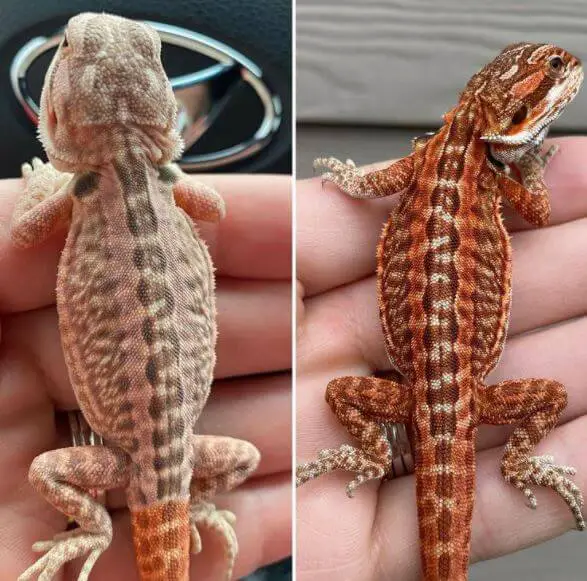
You already know why and when you should change your pet’s diet. Let’s come to know how to get them used to this change.
Bearded dragons can be uncomfortable if they are forced to eat the foods they don’t like, such as fresh vegetables.
I want to let you know how to make sure you ease them into the fresh food.
Remember that you never just suddenly cut their protein down to 20% overnight and want them to eat a lot of vegetables and greens.
I suggest weaning them back on protein slowly from 9-12 months and give more vegetables also.
Besides, you should mix it up with vegetables and throw in small fruit.
4. Can I Overfeed My Bearded Dragon?
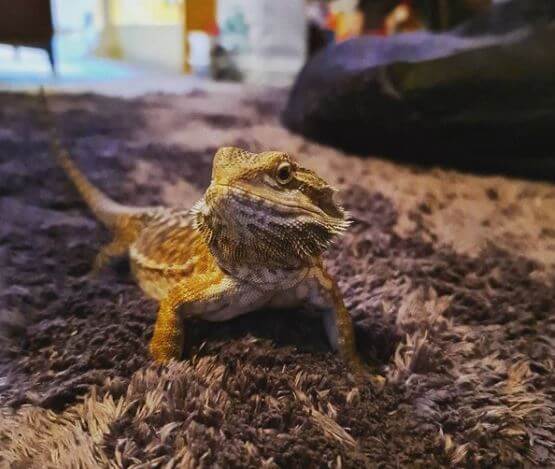
Of course, yes! Just like people, a beardie can become overweight from an overindulgent diet.
Being overweight can become a problem in the mature beardie.
Usually, obesity happens when the diet is rich in delicious things such as insects and deficient in veggies.
5. How Long Can My Bearded Dragon Go Without Eating?
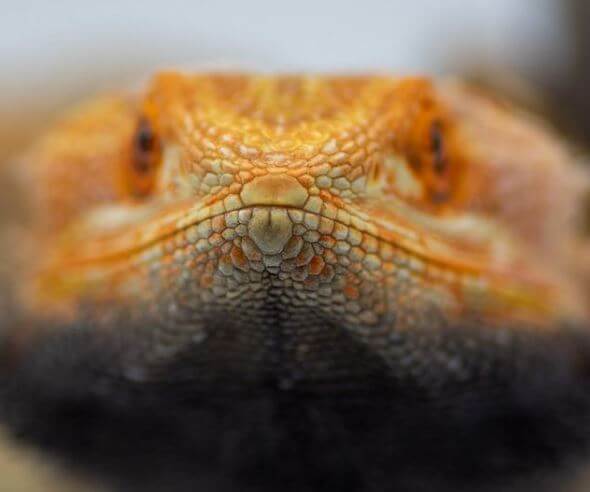
Just like humans, it depends on the pet’s current health situation. Adult dragons will have plenty of fat stored in their body. It is not easy to lose quickly.
Thus, they can go up to 2 months without food. It is not encouraged.
On the other hand, the juveniles growing quickly and stopping eating might cause some concern because they need protein to grow up strong and healthy.
6. How to Tame Baby Bearded Dragons?
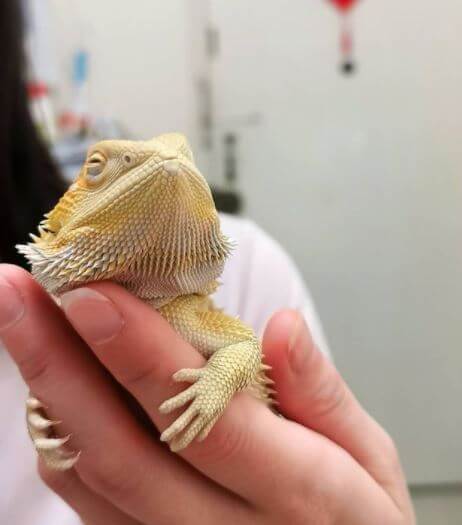
Before you handle them, you should wait at least one week.
The baby dragons are more skittish than the adult bearded dragon.
The babies are tiny and should be held with very careful treats.
Once your pet is regularly eating, you can start to tame him.
- To begin with, you can offer your hand and coax him slowly, carefully, and gently.
- Without making any sudden time holding him underneath his belly and supporting the weight.
- Don’t grab him from above or the tail
If you handle your beardie nicely, you can expect them to be relaxed and happy being handled.
7. What Kind of Fruits to Feed My Bearded Dragon?

What fruits do baby bearded dragons eat?
There are a lot of fruits that are safe and nutritious for a baby bearded dragon.
However, some contain a high amount of sugar that is not healthy for their teeth and causes obesity.
Beardies do not need to eat fruits if they eat vegetables and greens because most of the nutrients will come from them.
If you don’t want to allow your pet to eat fruits, it is totally fine.
The following are some safe fruits for beardies:
- Strawberries
- Plums
- Apples
- Figs
- Blackberries
- Raisins
- Pineapples
- Melons
- Grapes
- Pears
- Cherries
- Peaches
Read More:
- Can Bearded Dragons Eat Brussels Sprouts?
- Do Bearded Dragons Eat Peas?
- Can Bearded Dragons Eat Rosemary?
- Can Bearded Dragons Eat Dill?
- Do Bearded Dragons Eat Radish Greens?
8. How Often Can I Hold My Baby Bearded Dragons?

You should try to hold them for 15 minutes/day. It will help them get used to being handled.
You can extend the periods for as long as your dragons look comfortable.
Some babies do not like being held for a long time, while others love it and will allow you to hold it several times/day.
9. How Do I Know If My Baby Bearded Dragons Are Happy?
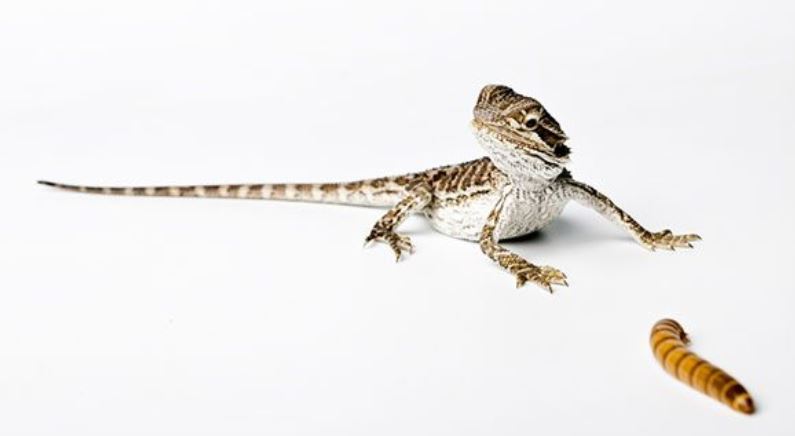
There are several signs to let you know when your pet gets happy:
- They will not run away from you.
- They will lay on you for a long time.
- Willing to go on your shoulder.
- Let you handle them up.
- No any signs of aggression.
- Baby bearded dragons eating, basking, pooping, and sleeping as normal.
- Ask you to come to hang out.
- Look alert and healthy.
10. Can I Kiss My Bearded Dragon?
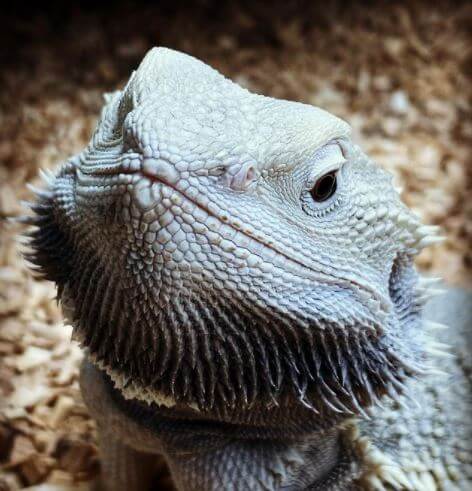
Although the beardies are cute and adorable, don’t kiss them as it is an easy way to contract salmonella.
Keep them away from your face, especially around your nose and mouth.
Conclusion
What food do baby bearded dragons eat?
Taking care of baby beardies is not simple for anyone, especially if they don’t know the baby bearded dragon diet.
To start appropriately, find out the critical information and practice the excellent skill for loving your pet.
I hope that this page has helped you understand how you can feed your baby bearded dragon and answered the question, “What food do baby bearded dragons eat?”
Key points to remember when thinking about your baby bearded dragon’s diet:
Feeding a baby bearded dragon requires specific attention to nutrition and dietary requirements to support their growth and overall health. Here’s a guide with key points on the diet of baby bearded dragons:
1. Protein-Rich Insects:
- Primary Diet: Baby bearded dragons thrive on a diet primarily composed of live insects, providing essential protein for their growth.
- Variety is Key: Offer a variety of insects, including appropriately sized crickets, small dubia roaches, small phoenix worms, and small mealworms.
2. Dusting Insects:
- Calcium and Vitamin Supplementation: Dust the insects with calcium powder at almost every feeding, and use a vitamin supplement (specifically designed for reptiles) once or twice a week.
- Proper Balance: Ensuring a correct calcium-to-phosphorus ratio is vital to prevent metabolic bone disease (MBD).
3. Offer Fresh Vegetables:
- Gradual Introduction: Start introducing finely chopped or grated leafy greens and vegetables once your baby bearded dragon is around 2 to 3 months old.
- Safe Vegetables: Offer safe vegetables like collard greens, mustard greens, dandelion greens, and butternut squash. Avoid high-oxalate greens like spinach.
4. Age-Appropriate Serving Sizes:
- Adjust Serving Size: Offer smaller insect portions and vegetable servings relative to the dragon’s size, gradually increasing as they grow.
5. Frequency of Feeding:
- Young Dragons: Feed baby bearded dragons multiple times a day, usually 2-3 times, to accommodate their rapid growth and metabolism.
- Monitoring Appetite: Pay attention to your dragon’s appetite and adjust the frequency and portion size accordingly.
6. Hydration:
- Water Bowl: Always provide a shallow, easily accessible water bowl for your baby bearded dragon. However, most of their hydration comes from their food.
7. Avoid Citrus and Sugary Foods:
- Harmful Foods: Never feed citrus fruits, sugary foods, or high-fiber items to baby bearded dragons, as these can be harmful to their digestive system.
8. Gut Loading Insects:
- Nutrient Transfer: Ensure the insects are “gut loaded” with nutritious foods before feeding to transfer those nutrients to your dragon.
9. Supervision:
- Close Monitoring: Supervise feedings to ensure your baby bearded dragon is eating properly and that insects don’t escape or harm your pet.
10. Transition to Adult Diet:
- Gradual Transition: As your dragon matures, gradually shift from a predominantly insect-based diet to a more balanced adult diet with a higher vegetable content.
11. Veterinary Check-Up:
- Regular Exams: Schedule regular veterinary check-ups to monitor your dragon’s growth and health. This is especially important during the first year of their life.
12. Temperature and Lighting:
- Proper Conditions: Maintain the correct temperature and UVB lighting in the enclosure, as these factors play a crucial role in your baby bearded dragon’s health and appetite.
Conclusion:
Feeding your baby bearded dragon a balanced diet of appropriately sized live insects and fresh vegetables is essential for their healthy growth and development. Pay close attention to their dietary requirements, adjust portions and supplements as they grow, and provide a safe and hygienic feeding environment. Remember to consult with a reptile veterinarian for specific dietary guidance and regular check-ups to ensure your baby bearded dragon’s well-being.
Further Reading:
- Top 5 Best Automatic Reptile Feeders
- Best Food for Tortoise: Buying Guide and Reviews
- Can Bearded Dragons Get High?
- Why Are My Bearded Dragons Fighting to Death?
- How Often to Trim Bearded Dragon Nails?

